Financial Tools for Non-Financial Managers: Task 1 and 2 Report
VerifiedAdded on 2020/07/22
|18
|4104
|110
Report
AI Summary
This report provides a comprehensive analysis of financial tools and techniques relevant to non-financial managers, covering two main tasks. Task 1 delves into short-term decision-making tools, including financial statements, forecasting, budgeting, ratio analysis, investment analysis, cost requirements, variance analysis, marginal costing, and absorption costing. It also evaluates modern management accounting techniques such as activity-based costing, just-in-time inventory management, the balance scorecard, and return on investment. Task 2 focuses on investment appraisal techniques, exploring alternative methods and evaluating risk management techniques. The report discusses the advantages and disadvantages of each tool, providing a practical guide for enhancing financial decision-making within organizations. The report concludes with a detailed evaluation of ratio analysis as a tool for performance assessment.
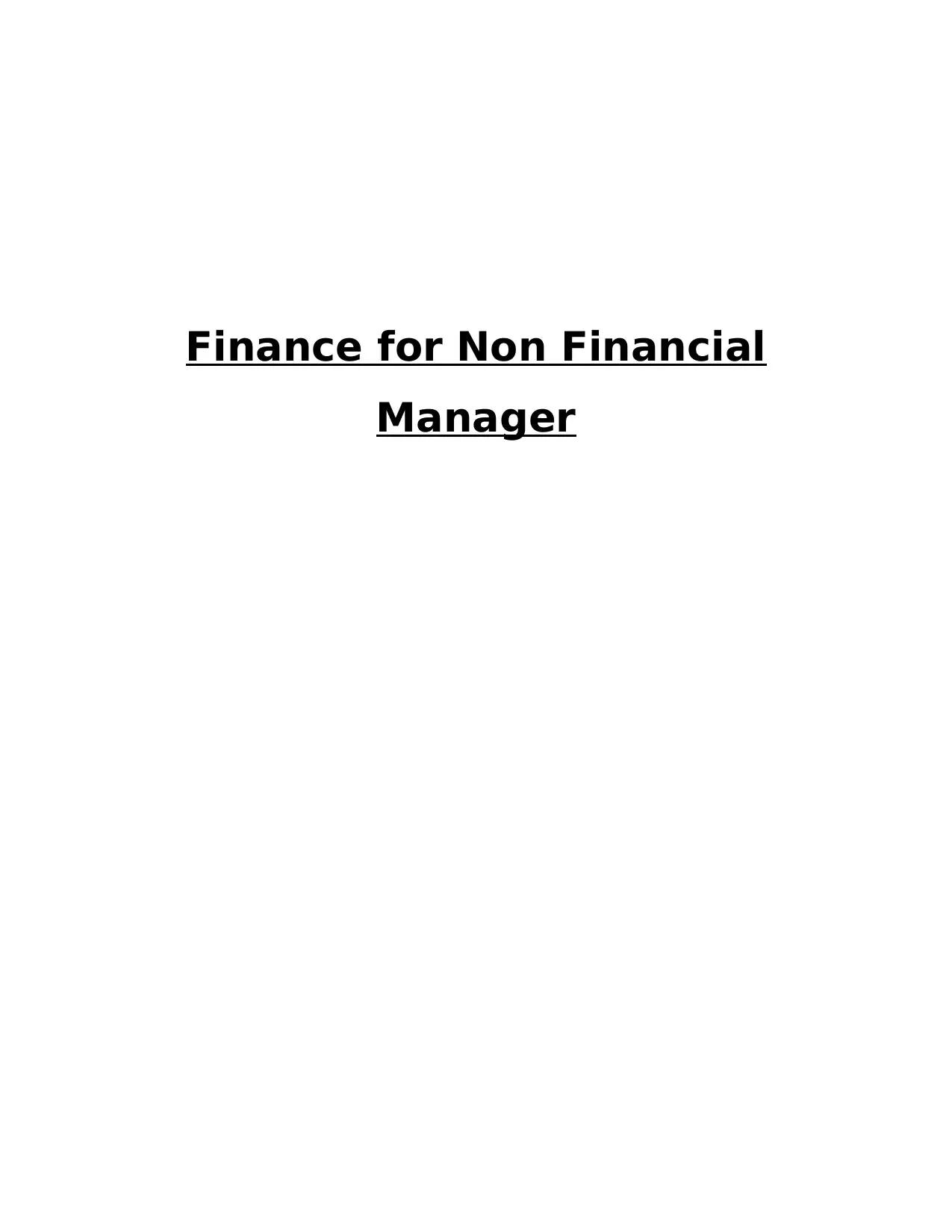
Finance for Non Financial
Manager
Manager
Paraphrase This Document
Need a fresh take? Get an instant paraphrase of this document with our AI Paraphraser
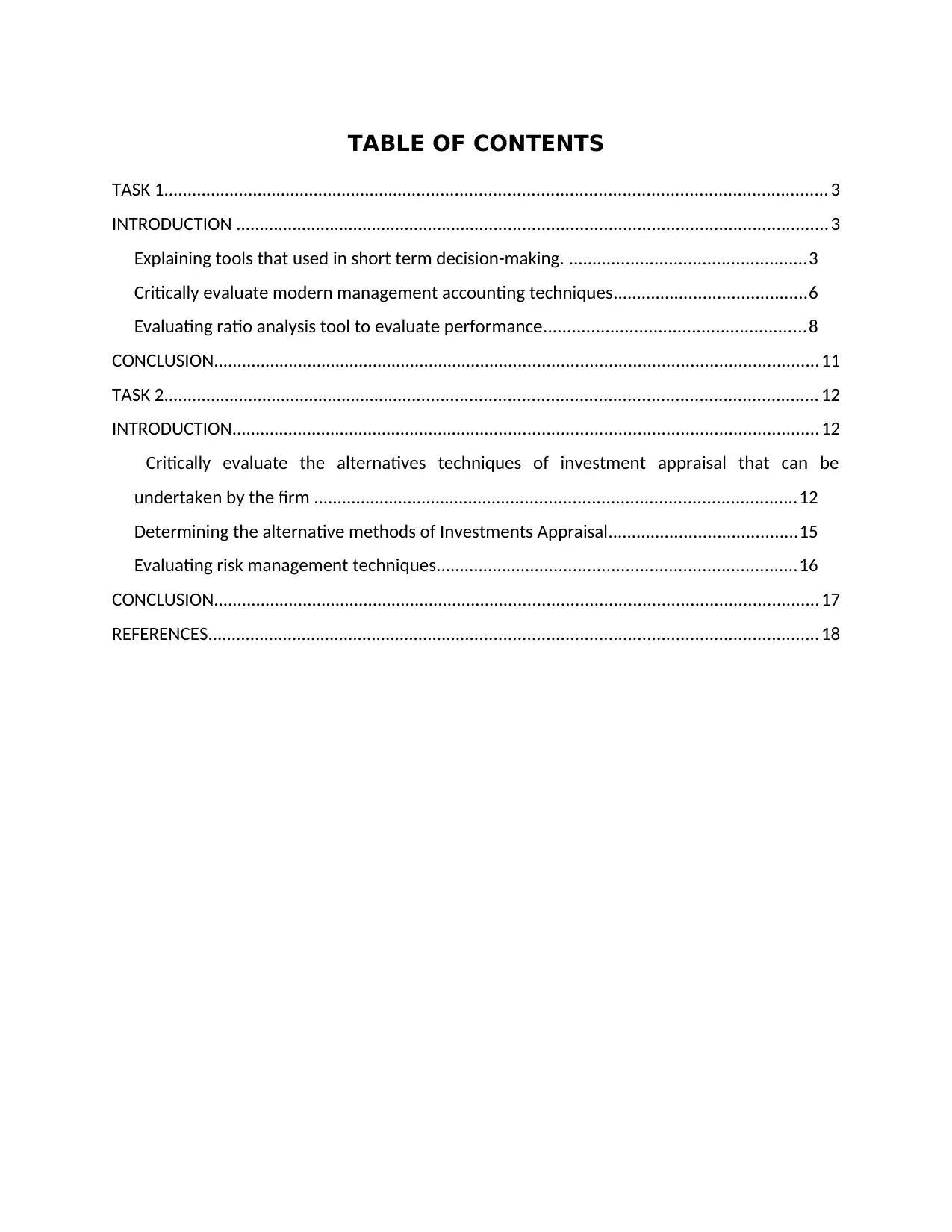
TABLE OF CONTENTS
TASK 1............................................................................................................................................ 3
INTRODUCTION .............................................................................................................................3
Explaining tools that used in short term decision-making. ..................................................3
Critically evaluate modern management accounting techniques.........................................6
Evaluating ratio analysis tool to evaluate performance.......................................................8
CONCLUSION................................................................................................................................11
TASK 2.......................................................................................................................................... 12
INTRODUCTION............................................................................................................................12
Critically evaluate the alternatives techniques of investment appraisal that can be
undertaken by the firm ......................................................................................................12
Determining the alternative methods of Investments Appraisal........................................15
Evaluating risk management techniques............................................................................16
CONCLUSION................................................................................................................................17
REFERENCES................................................................................................................................. 18
TASK 1............................................................................................................................................ 3
INTRODUCTION .............................................................................................................................3
Explaining tools that used in short term decision-making. ..................................................3
Critically evaluate modern management accounting techniques.........................................6
Evaluating ratio analysis tool to evaluate performance.......................................................8
CONCLUSION................................................................................................................................11
TASK 2.......................................................................................................................................... 12
INTRODUCTION............................................................................................................................12
Critically evaluate the alternatives techniques of investment appraisal that can be
undertaken by the firm ......................................................................................................12
Determining the alternative methods of Investments Appraisal........................................15
Evaluating risk management techniques............................................................................16
CONCLUSION................................................................................................................................17
REFERENCES................................................................................................................................. 18
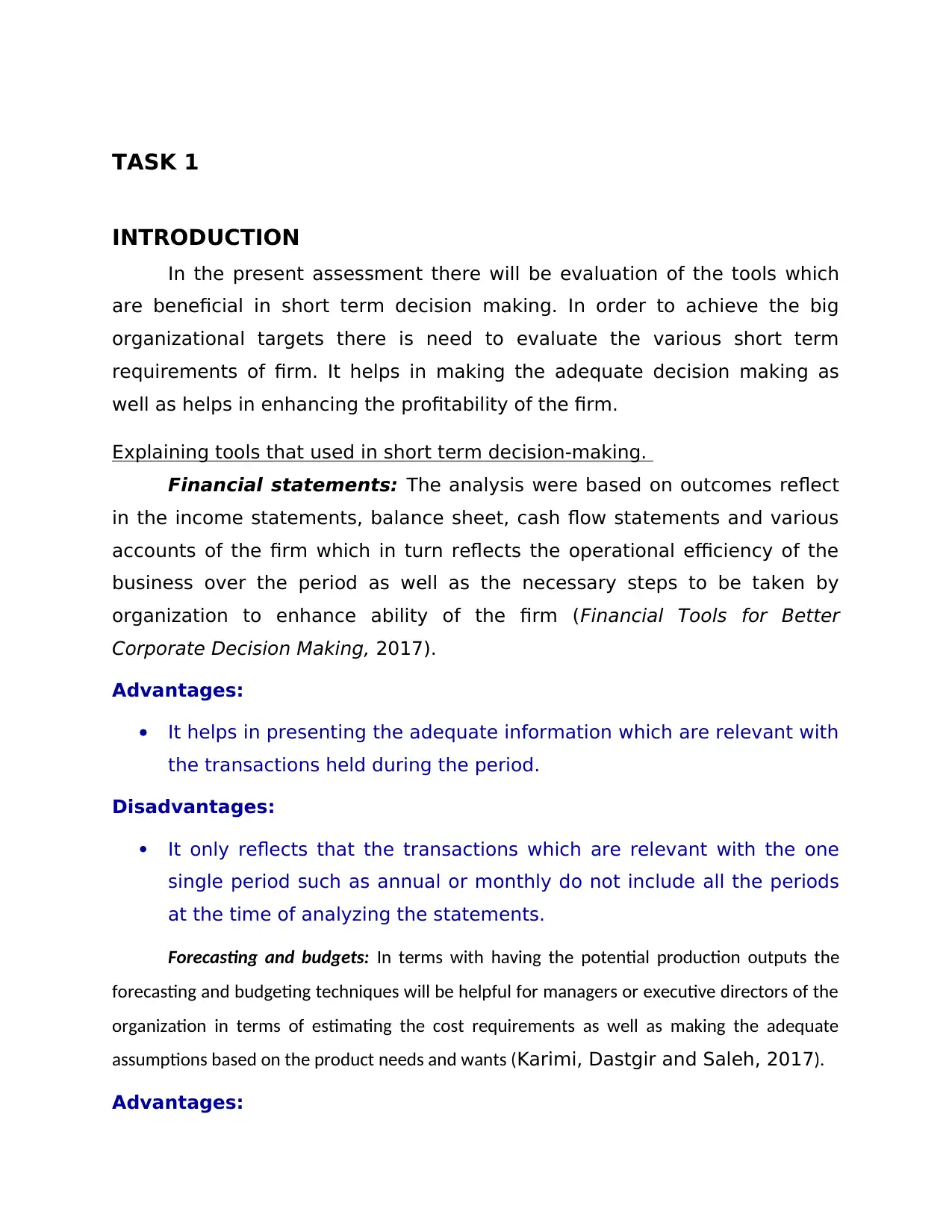
TASK 1
INTRODUCTION
In the present assessment there will be evaluation of the tools which
are beneficial in short term decision making. In order to achieve the big
organizational targets there is need to evaluate the various short term
requirements of firm. It helps in making the adequate decision making as
well as helps in enhancing the profitability of the firm.
Explaining tools that used in short term decision-making.
Financial statements: The analysis were based on outcomes reflect
in the income statements, balance sheet, cash flow statements and various
accounts of the firm which in turn reflects the operational efficiency of the
business over the period as well as the necessary steps to be taken by
organization to enhance ability of the firm (Financial Tools for Better
Corporate Decision Making, 2017).
Advantages:
It helps in presenting the adequate information which are relevant with
the transactions held during the period.
Disadvantages:
It only reflects that the transactions which are relevant with the one
single period such as annual or monthly do not include all the periods
at the time of analyzing the statements.
Forecasting and budgets: In terms with having the potential production outputs the
forecasting and budgeting techniques will be helpful for managers or executive directors of the
organization in terms of estimating the cost requirements as well as making the adequate
assumptions based on the product needs and wants (Karimi, Dastgir and Saleh, 2017).
Advantages:
INTRODUCTION
In the present assessment there will be evaluation of the tools which
are beneficial in short term decision making. In order to achieve the big
organizational targets there is need to evaluate the various short term
requirements of firm. It helps in making the adequate decision making as
well as helps in enhancing the profitability of the firm.
Explaining tools that used in short term decision-making.
Financial statements: The analysis were based on outcomes reflect
in the income statements, balance sheet, cash flow statements and various
accounts of the firm which in turn reflects the operational efficiency of the
business over the period as well as the necessary steps to be taken by
organization to enhance ability of the firm (Financial Tools for Better
Corporate Decision Making, 2017).
Advantages:
It helps in presenting the adequate information which are relevant with
the transactions held during the period.
Disadvantages:
It only reflects that the transactions which are relevant with the one
single period such as annual or monthly do not include all the periods
at the time of analyzing the statements.
Forecasting and budgets: In terms with having the potential production outputs the
forecasting and budgeting techniques will be helpful for managers or executive directors of the
organization in terms of estimating the cost requirements as well as making the adequate
assumptions based on the product needs and wants (Karimi, Dastgir and Saleh, 2017).
Advantages:
⊘ This is a preview!⊘
Do you want full access?
Subscribe today to unlock all pages.

Trusted by 1+ million students worldwide
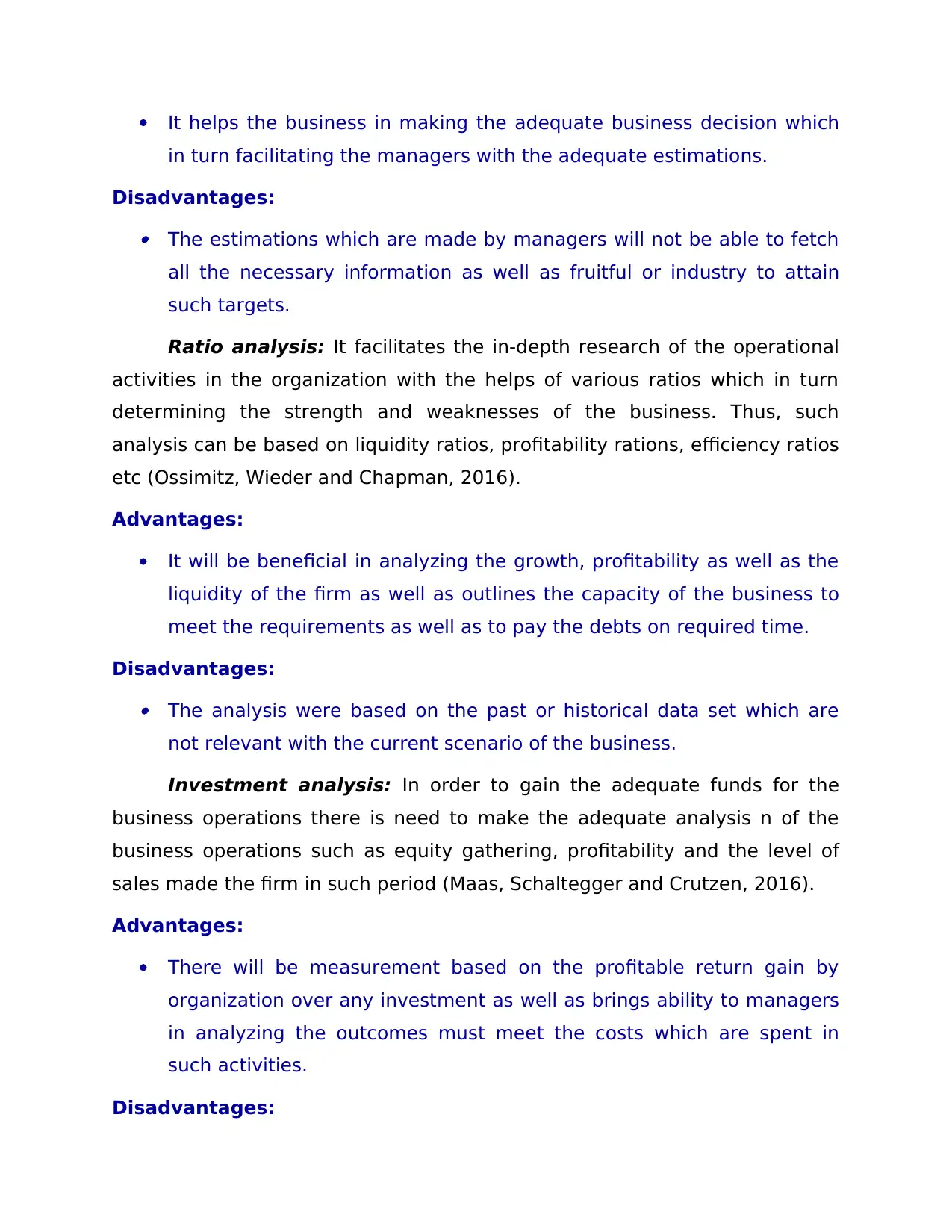
It helps the business in making the adequate business decision which
in turn facilitating the managers with the adequate estimations.
Disadvantages: The estimations which are made by managers will not be able to fetch
all the necessary information as well as fruitful or industry to attain
such targets.
Ratio analysis: It facilitates the in-depth research of the operational
activities in the organization with the helps of various ratios which in turn
determining the strength and weaknesses of the business. Thus, such
analysis can be based on liquidity ratios, profitability rations, efficiency ratios
etc (Ossimitz, Wieder and Chapman, 2016).
Advantages:
It will be beneficial in analyzing the growth, profitability as well as the
liquidity of the firm as well as outlines the capacity of the business to
meet the requirements as well as to pay the debts on required time.
Disadvantages: The analysis were based on the past or historical data set which are
not relevant with the current scenario of the business.
Investment analysis: In order to gain the adequate funds for the
business operations there is need to make the adequate analysis n of the
business operations such as equity gathering, profitability and the level of
sales made the firm in such period (Maas, Schaltegger and Crutzen, 2016).
Advantages:
There will be measurement based on the profitable return gain by
organization over any investment as well as brings ability to managers
in analyzing the outcomes must meet the costs which are spent in
such activities.
Disadvantages:
in turn facilitating the managers with the adequate estimations.
Disadvantages: The estimations which are made by managers will not be able to fetch
all the necessary information as well as fruitful or industry to attain
such targets.
Ratio analysis: It facilitates the in-depth research of the operational
activities in the organization with the helps of various ratios which in turn
determining the strength and weaknesses of the business. Thus, such
analysis can be based on liquidity ratios, profitability rations, efficiency ratios
etc (Ossimitz, Wieder and Chapman, 2016).
Advantages:
It will be beneficial in analyzing the growth, profitability as well as the
liquidity of the firm as well as outlines the capacity of the business to
meet the requirements as well as to pay the debts on required time.
Disadvantages: The analysis were based on the past or historical data set which are
not relevant with the current scenario of the business.
Investment analysis: In order to gain the adequate funds for the
business operations there is need to make the adequate analysis n of the
business operations such as equity gathering, profitability and the level of
sales made the firm in such period (Maas, Schaltegger and Crutzen, 2016).
Advantages:
There will be measurement based on the profitable return gain by
organization over any investment as well as brings ability to managers
in analyzing the outcomes must meet the costs which are spent in
such activities.
Disadvantages:
Paraphrase This Document
Need a fresh take? Get an instant paraphrase of this document with our AI Paraphraser
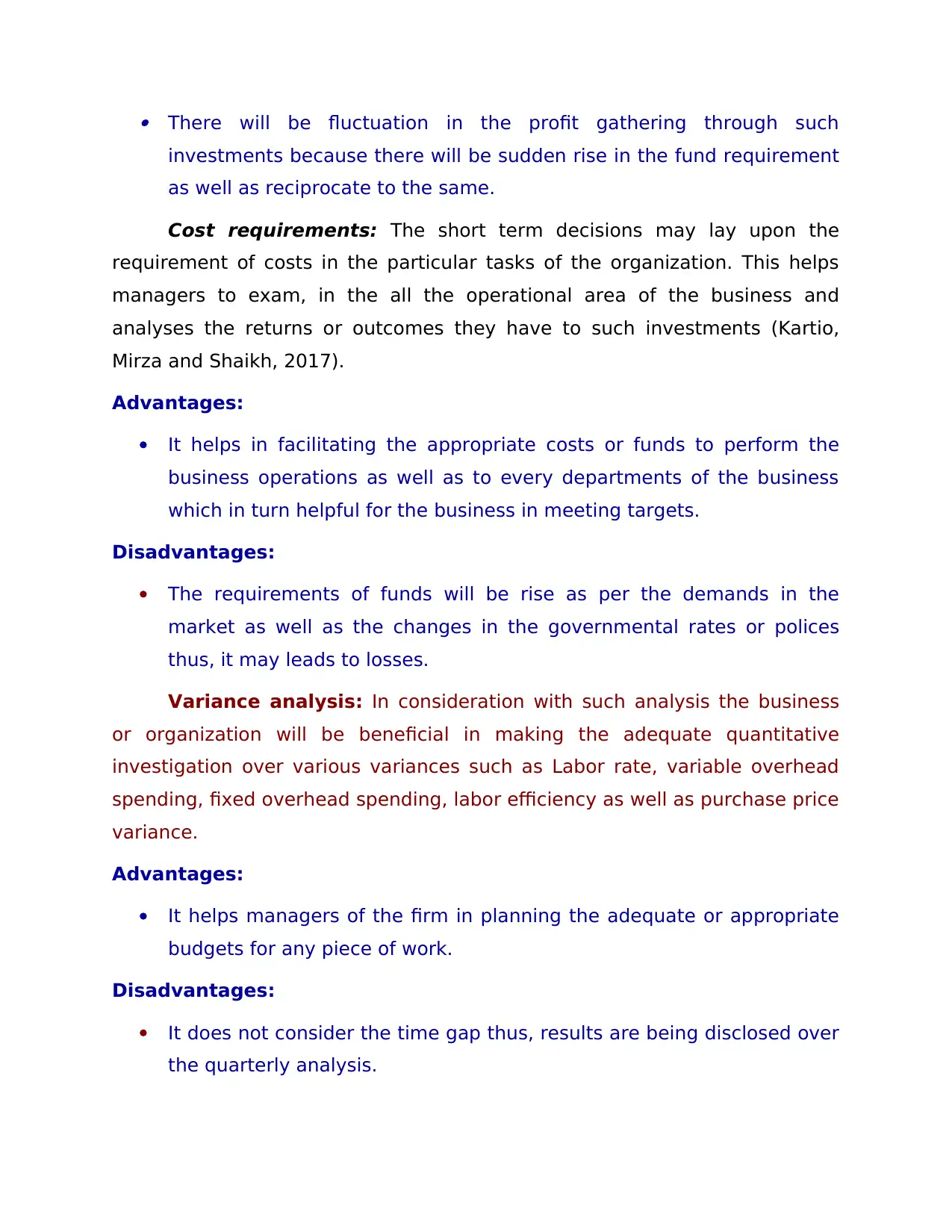
There will be fluctuation in the profit gathering through such
investments because there will be sudden rise in the fund requirement
as well as reciprocate to the same.
Cost requirements: The short term decisions may lay upon the
requirement of costs in the particular tasks of the organization. This helps
managers to exam, in the all the operational area of the business and
analyses the returns or outcomes they have to such investments (Kartio,
Mirza and Shaikh, 2017).
Advantages:
It helps in facilitating the appropriate costs or funds to perform the
business operations as well as to every departments of the business
which in turn helpful for the business in meeting targets.
Disadvantages:
The requirements of funds will be rise as per the demands in the
market as well as the changes in the governmental rates or polices
thus, it may leads to losses.
Variance analysis: In consideration with such analysis the business
or organization will be beneficial in making the adequate quantitative
investigation over various variances such as Labor rate, variable overhead
spending, fixed overhead spending, labor efficiency as well as purchase price
variance.
Advantages:
It helps managers of the firm in planning the adequate or appropriate
budgets for any piece of work.
Disadvantages:
It does not consider the time gap thus, results are being disclosed over
the quarterly analysis.
investments because there will be sudden rise in the fund requirement
as well as reciprocate to the same.
Cost requirements: The short term decisions may lay upon the
requirement of costs in the particular tasks of the organization. This helps
managers to exam, in the all the operational area of the business and
analyses the returns or outcomes they have to such investments (Kartio,
Mirza and Shaikh, 2017).
Advantages:
It helps in facilitating the appropriate costs or funds to perform the
business operations as well as to every departments of the business
which in turn helpful for the business in meeting targets.
Disadvantages:
The requirements of funds will be rise as per the demands in the
market as well as the changes in the governmental rates or polices
thus, it may leads to losses.
Variance analysis: In consideration with such analysis the business
or organization will be beneficial in making the adequate quantitative
investigation over various variances such as Labor rate, variable overhead
spending, fixed overhead spending, labor efficiency as well as purchase price
variance.
Advantages:
It helps managers of the firm in planning the adequate or appropriate
budgets for any piece of work.
Disadvantages:
It does not consider the time gap thus, results are being disclosed over
the quarterly analysis.
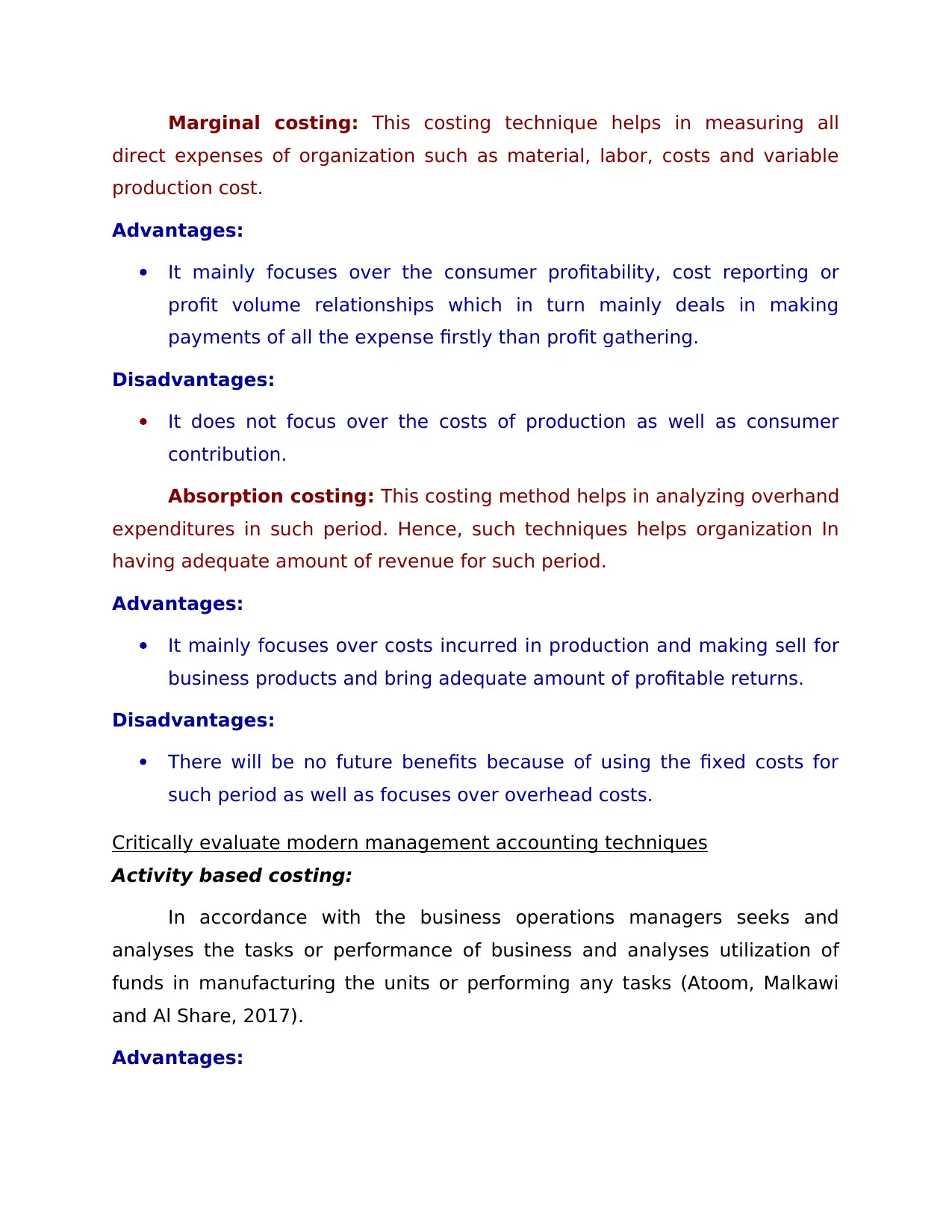
Marginal costing: This costing technique helps in measuring all
direct expenses of organization such as material, labor, costs and variable
production cost.
Advantages:
It mainly focuses over the consumer profitability, cost reporting or
profit volume relationships which in turn mainly deals in making
payments of all the expense firstly than profit gathering.
Disadvantages:
It does not focus over the costs of production as well as consumer
contribution.
Absorption costing: This costing method helps in analyzing overhand
expenditures in such period. Hence, such techniques helps organization In
having adequate amount of revenue for such period.
Advantages:
It mainly focuses over costs incurred in production and making sell for
business products and bring adequate amount of profitable returns.
Disadvantages:
There will be no future benefits because of using the fixed costs for
such period as well as focuses over overhead costs.
Critically evaluate modern management accounting techniques
Activity based costing:
In accordance with the business operations managers seeks and
analyses the tasks or performance of business and analyses utilization of
funds in manufacturing the units or performing any tasks (Atoom, Malkawi
and Al Share, 2017).
Advantages:
direct expenses of organization such as material, labor, costs and variable
production cost.
Advantages:
It mainly focuses over the consumer profitability, cost reporting or
profit volume relationships which in turn mainly deals in making
payments of all the expense firstly than profit gathering.
Disadvantages:
It does not focus over the costs of production as well as consumer
contribution.
Absorption costing: This costing method helps in analyzing overhand
expenditures in such period. Hence, such techniques helps organization In
having adequate amount of revenue for such period.
Advantages:
It mainly focuses over costs incurred in production and making sell for
business products and bring adequate amount of profitable returns.
Disadvantages:
There will be no future benefits because of using the fixed costs for
such period as well as focuses over overhead costs.
Critically evaluate modern management accounting techniques
Activity based costing:
In accordance with the business operations managers seeks and
analyses the tasks or performance of business and analyses utilization of
funds in manufacturing the units or performing any tasks (Atoom, Malkawi
and Al Share, 2017).
Advantages:
⊘ This is a preview!⊘
Do you want full access?
Subscribe today to unlock all pages.

Trusted by 1+ million students worldwide
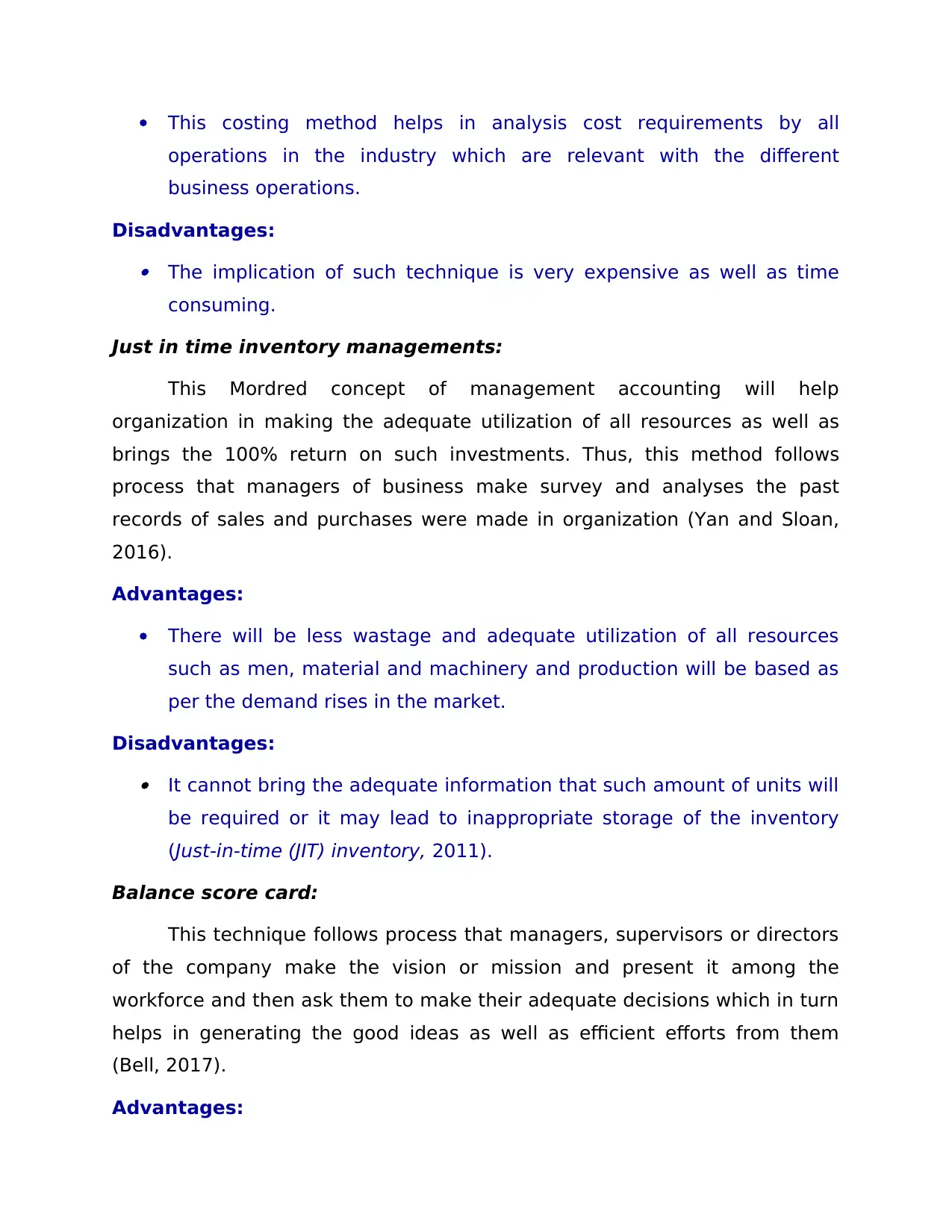
This costing method helps in analysis cost requirements by all
operations in the industry which are relevant with the different
business operations.
Disadvantages: The implication of such technique is very expensive as well as time
consuming.
Just in time inventory managements:
This Mordred concept of management accounting will help
organization in making the adequate utilization of all resources as well as
brings the 100% return on such investments. Thus, this method follows
process that managers of business make survey and analyses the past
records of sales and purchases were made in organization (Yan and Sloan,
2016).
Advantages:
There will be less wastage and adequate utilization of all resources
such as men, material and machinery and production will be based as
per the demand rises in the market.
Disadvantages: It cannot bring the adequate information that such amount of units will
be required or it may lead to inappropriate storage of the inventory
(Just-in-time (JIT) inventory, 2011).
Balance score card:
This technique follows process that managers, supervisors or directors
of the company make the vision or mission and present it among the
workforce and then ask them to make their adequate decisions which in turn
helps in generating the good ideas as well as efficient efforts from them
(Bell, 2017).
Advantages:
operations in the industry which are relevant with the different
business operations.
Disadvantages: The implication of such technique is very expensive as well as time
consuming.
Just in time inventory managements:
This Mordred concept of management accounting will help
organization in making the adequate utilization of all resources as well as
brings the 100% return on such investments. Thus, this method follows
process that managers of business make survey and analyses the past
records of sales and purchases were made in organization (Yan and Sloan,
2016).
Advantages:
There will be less wastage and adequate utilization of all resources
such as men, material and machinery and production will be based as
per the demand rises in the market.
Disadvantages: It cannot bring the adequate information that such amount of units will
be required or it may lead to inappropriate storage of the inventory
(Just-in-time (JIT) inventory, 2011).
Balance score card:
This technique follows process that managers, supervisors or directors
of the company make the vision or mission and present it among the
workforce and then ask them to make their adequate decisions which in turn
helps in generating the good ideas as well as efficient efforts from them
(Bell, 2017).
Advantages:
Paraphrase This Document
Need a fresh take? Get an instant paraphrase of this document with our AI Paraphraser
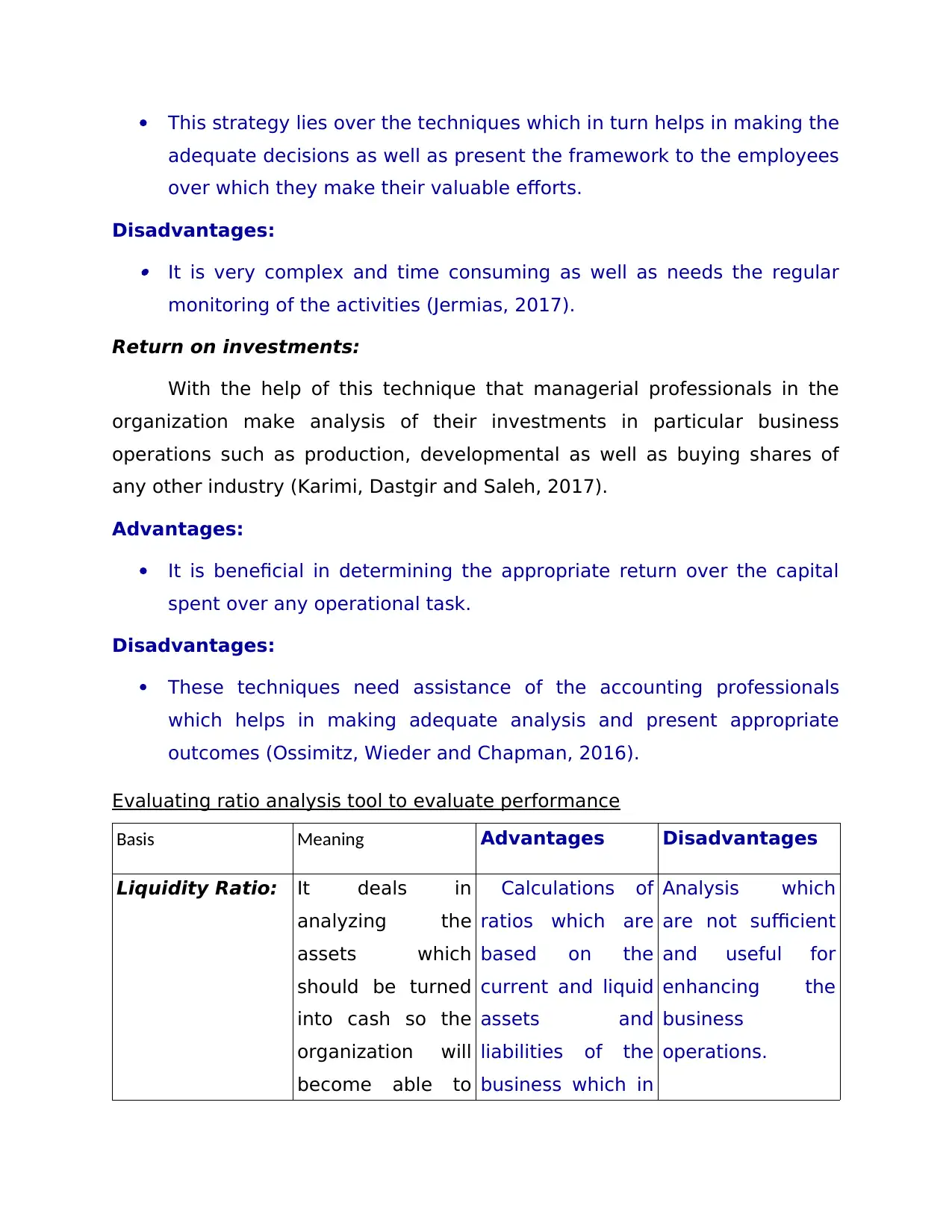
This strategy lies over the techniques which in turn helps in making the
adequate decisions as well as present the framework to the employees
over which they make their valuable efforts.
Disadvantages: It is very complex and time consuming as well as needs the regular
monitoring of the activities (Jermias, 2017).
Return on investments:
With the help of this technique that managerial professionals in the
organization make analysis of their investments in particular business
operations such as production, developmental as well as buying shares of
any other industry (Karimi, Dastgir and Saleh, 2017).
Advantages:
It is beneficial in determining the appropriate return over the capital
spent over any operational task.
Disadvantages:
These techniques need assistance of the accounting professionals
which helps in making adequate analysis and present appropriate
outcomes (Ossimitz, Wieder and Chapman, 2016).
Evaluating ratio analysis tool to evaluate performance
Basis Meaning Advantages Disadvantages
Liquidity Ratio: It deals in
analyzing the
assets which
should be turned
into cash so the
organization will
become able to
Calculations of
ratios which are
based on the
current and liquid
assets and
liabilities of the
business which in
Analysis which
are not sufficient
and useful for
enhancing the
business
operations.
adequate decisions as well as present the framework to the employees
over which they make their valuable efforts.
Disadvantages: It is very complex and time consuming as well as needs the regular
monitoring of the activities (Jermias, 2017).
Return on investments:
With the help of this technique that managerial professionals in the
organization make analysis of their investments in particular business
operations such as production, developmental as well as buying shares of
any other industry (Karimi, Dastgir and Saleh, 2017).
Advantages:
It is beneficial in determining the appropriate return over the capital
spent over any operational task.
Disadvantages:
These techniques need assistance of the accounting professionals
which helps in making adequate analysis and present appropriate
outcomes (Ossimitz, Wieder and Chapman, 2016).
Evaluating ratio analysis tool to evaluate performance
Basis Meaning Advantages Disadvantages
Liquidity Ratio: It deals in
analyzing the
assets which
should be turned
into cash so the
organization will
become able to
Calculations of
ratios which are
based on the
current and liquid
assets and
liabilities of the
business which in
Analysis which
are not sufficient
and useful for
enhancing the
business
operations.
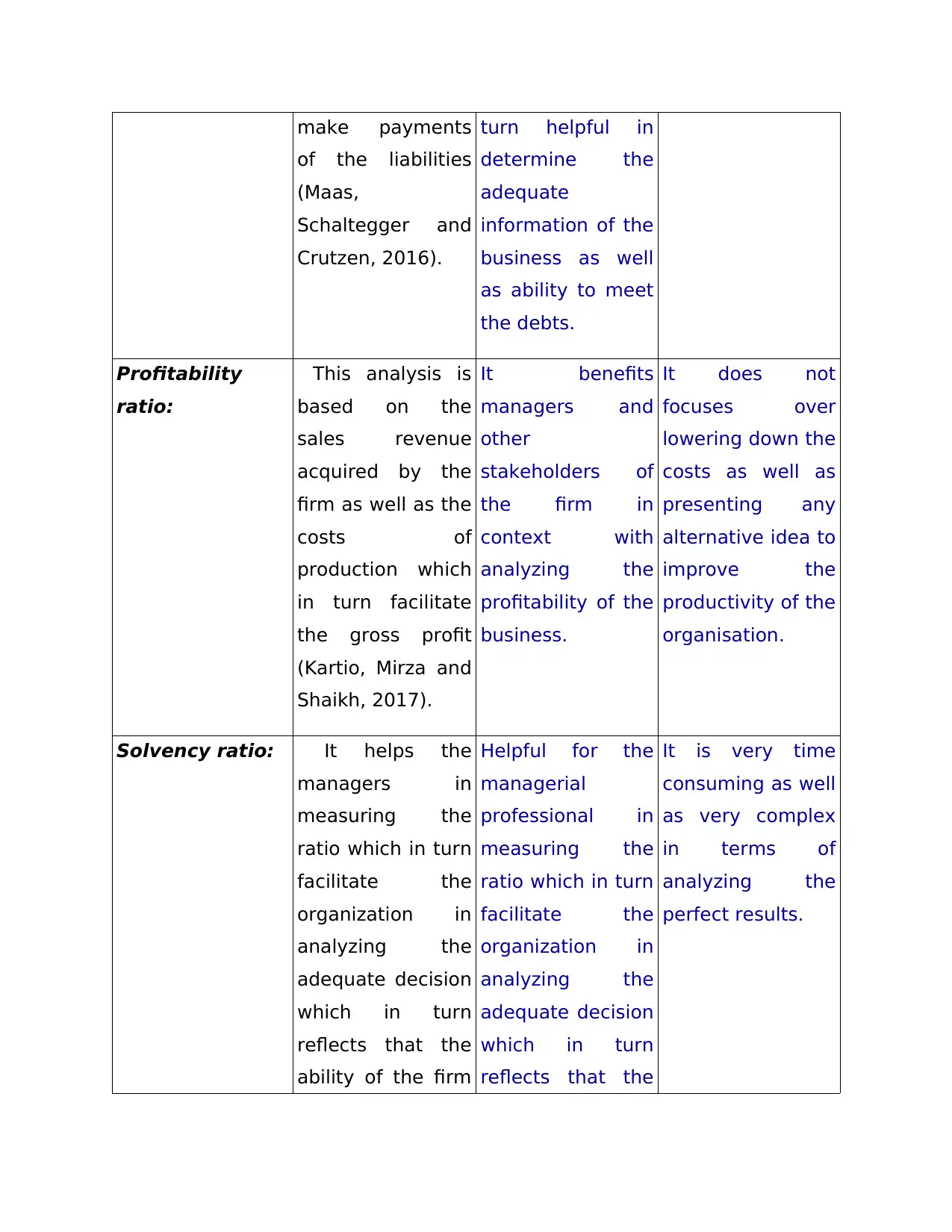
make payments
of the liabilities
(Maas,
Schaltegger and
Crutzen, 2016).
turn helpful in
determine the
adequate
information of the
business as well
as ability to meet
the debts.
Profitability
ratio:
This analysis is
based on the
sales revenue
acquired by the
firm as well as the
costs of
production which
in turn facilitate
the gross profit
(Kartio, Mirza and
Shaikh, 2017).
It benefits
managers and
other
stakeholders of
the firm in
context with
analyzing the
profitability of the
business.
It does not
focuses over
lowering down the
costs as well as
presenting any
alternative idea to
improve the
productivity of the
organisation.
Solvency ratio: It helps the
managers in
measuring the
ratio which in turn
facilitate the
organization in
analyzing the
adequate decision
which in turn
reflects that the
ability of the firm
Helpful for the
managerial
professional in
measuring the
ratio which in turn
facilitate the
organization in
analyzing the
adequate decision
which in turn
reflects that the
It is very time
consuming as well
as very complex
in terms of
analyzing the
perfect results.
of the liabilities
(Maas,
Schaltegger and
Crutzen, 2016).
turn helpful in
determine the
adequate
information of the
business as well
as ability to meet
the debts.
Profitability
ratio:
This analysis is
based on the
sales revenue
acquired by the
firm as well as the
costs of
production which
in turn facilitate
the gross profit
(Kartio, Mirza and
Shaikh, 2017).
It benefits
managers and
other
stakeholders of
the firm in
context with
analyzing the
profitability of the
business.
It does not
focuses over
lowering down the
costs as well as
presenting any
alternative idea to
improve the
productivity of the
organisation.
Solvency ratio: It helps the
managers in
measuring the
ratio which in turn
facilitate the
organization in
analyzing the
adequate decision
which in turn
reflects that the
ability of the firm
Helpful for the
managerial
professional in
measuring the
ratio which in turn
facilitate the
organization in
analyzing the
adequate decision
which in turn
reflects that the
It is very time
consuming as well
as very complex
in terms of
analyzing the
perfect results.
⊘ This is a preview!⊘
Do you want full access?
Subscribe today to unlock all pages.

Trusted by 1+ million students worldwide
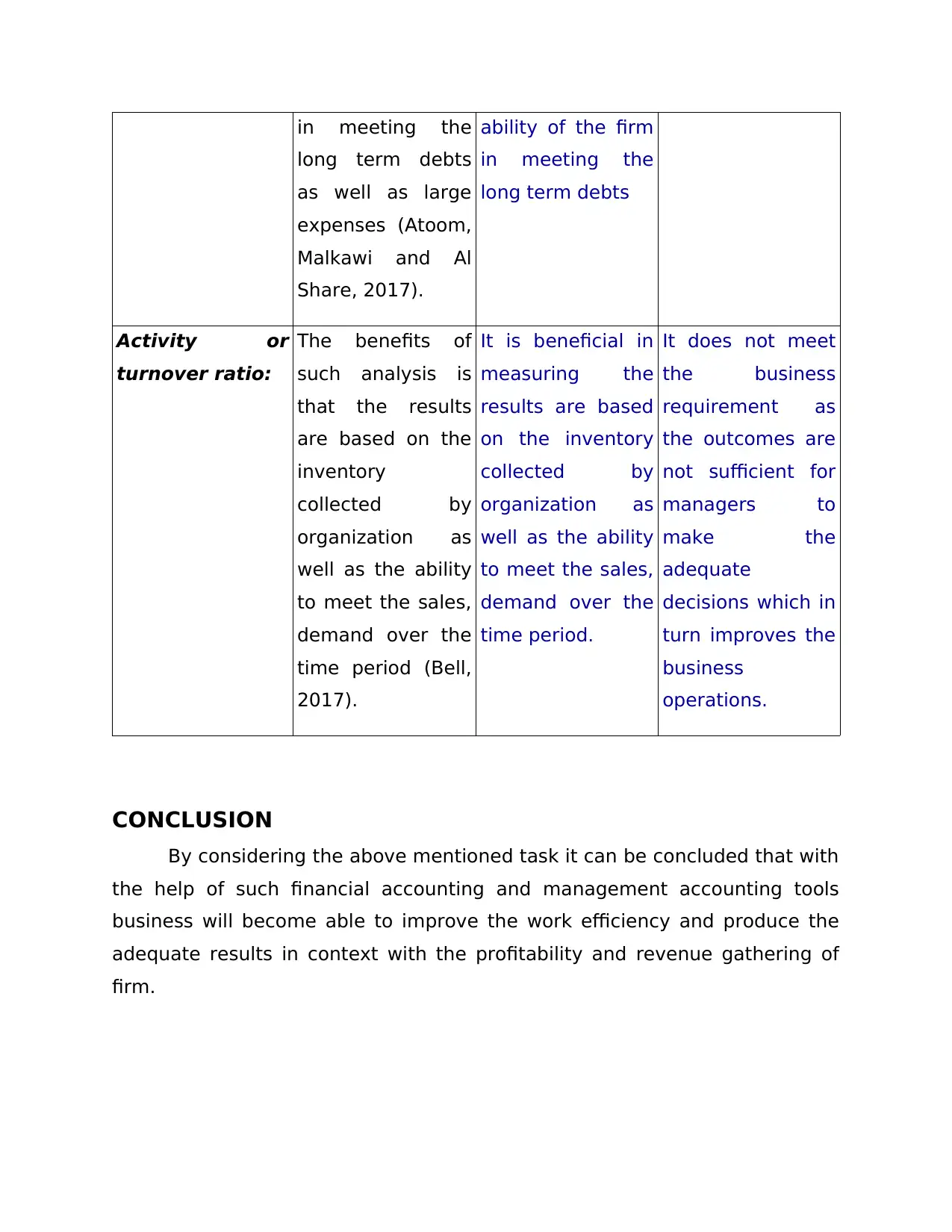
in meeting the
long term debts
as well as large
expenses (Atoom,
Malkawi and Al
Share, 2017).
ability of the firm
in meeting the
long term debts
Activity or
turnover ratio:
The benefits of
such analysis is
that the results
are based on the
inventory
collected by
organization as
well as the ability
to meet the sales,
demand over the
time period (Bell,
2017).
It is beneficial in
measuring the
results are based
on the inventory
collected by
organization as
well as the ability
to meet the sales,
demand over the
time period.
It does not meet
the business
requirement as
the outcomes are
not sufficient for
managers to
make the
adequate
decisions which in
turn improves the
business
operations.
CONCLUSION
By considering the above mentioned task it can be concluded that with
the help of such financial accounting and management accounting tools
business will become able to improve the work efficiency and produce the
adequate results in context with the profitability and revenue gathering of
firm.
long term debts
as well as large
expenses (Atoom,
Malkawi and Al
Share, 2017).
ability of the firm
in meeting the
long term debts
Activity or
turnover ratio:
The benefits of
such analysis is
that the results
are based on the
inventory
collected by
organization as
well as the ability
to meet the sales,
demand over the
time period (Bell,
2017).
It is beneficial in
measuring the
results are based
on the inventory
collected by
organization as
well as the ability
to meet the sales,
demand over the
time period.
It does not meet
the business
requirement as
the outcomes are
not sufficient for
managers to
make the
adequate
decisions which in
turn improves the
business
operations.
CONCLUSION
By considering the above mentioned task it can be concluded that with
the help of such financial accounting and management accounting tools
business will become able to improve the work efficiency and produce the
adequate results in context with the profitability and revenue gathering of
firm.
Paraphrase This Document
Need a fresh take? Get an instant paraphrase of this document with our AI Paraphraser
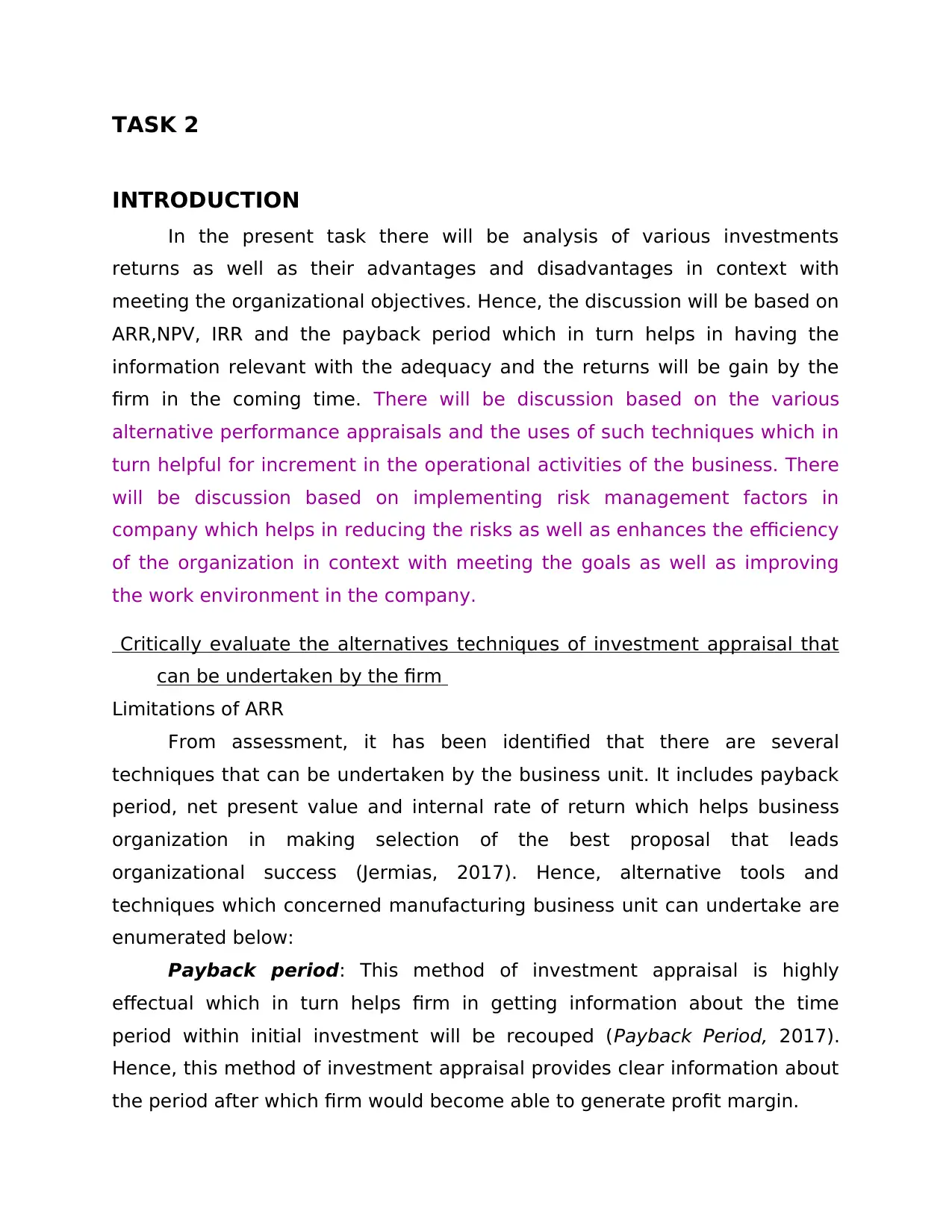
TASK 2
INTRODUCTION
In the present task there will be analysis of various investments
returns as well as their advantages and disadvantages in context with
meeting the organizational objectives. Hence, the discussion will be based on
ARR,NPV, IRR and the payback period which in turn helps in having the
information relevant with the adequacy and the returns will be gain by the
firm in the coming time. There will be discussion based on the various
alternative performance appraisals and the uses of such techniques which in
turn helpful for increment in the operational activities of the business. There
will be discussion based on implementing risk management factors in
company which helps in reducing the risks as well as enhances the efficiency
of the organization in context with meeting the goals as well as improving
the work environment in the company.
Critically evaluate the alternatives techniques of investment appraisal that
can be undertaken by the firm
Limitations of ARR
From assessment, it has been identified that there are several
techniques that can be undertaken by the business unit. It includes payback
period, net present value and internal rate of return which helps business
organization in making selection of the best proposal that leads
organizational success (Jermias, 2017). Hence, alternative tools and
techniques which concerned manufacturing business unit can undertake are
enumerated below:
Payback period: This method of investment appraisal is highly
effectual which in turn helps firm in getting information about the time
period within initial investment will be recouped (Payback Period, 2017).
Hence, this method of investment appraisal provides clear information about
the period after which firm would become able to generate profit margin.
INTRODUCTION
In the present task there will be analysis of various investments
returns as well as their advantages and disadvantages in context with
meeting the organizational objectives. Hence, the discussion will be based on
ARR,NPV, IRR and the payback period which in turn helps in having the
information relevant with the adequacy and the returns will be gain by the
firm in the coming time. There will be discussion based on the various
alternative performance appraisals and the uses of such techniques which in
turn helpful for increment in the operational activities of the business. There
will be discussion based on implementing risk management factors in
company which helps in reducing the risks as well as enhances the efficiency
of the organization in context with meeting the goals as well as improving
the work environment in the company.
Critically evaluate the alternatives techniques of investment appraisal that
can be undertaken by the firm
Limitations of ARR
From assessment, it has been identified that there are several
techniques that can be undertaken by the business unit. It includes payback
period, net present value and internal rate of return which helps business
organization in making selection of the best proposal that leads
organizational success (Jermias, 2017). Hence, alternative tools and
techniques which concerned manufacturing business unit can undertake are
enumerated below:
Payback period: This method of investment appraisal is highly
effectual which in turn helps firm in getting information about the time
period within initial investment will be recouped (Payback Period, 2017).
Hence, this method of investment appraisal provides clear information about
the period after which firm would become able to generate profit margin.
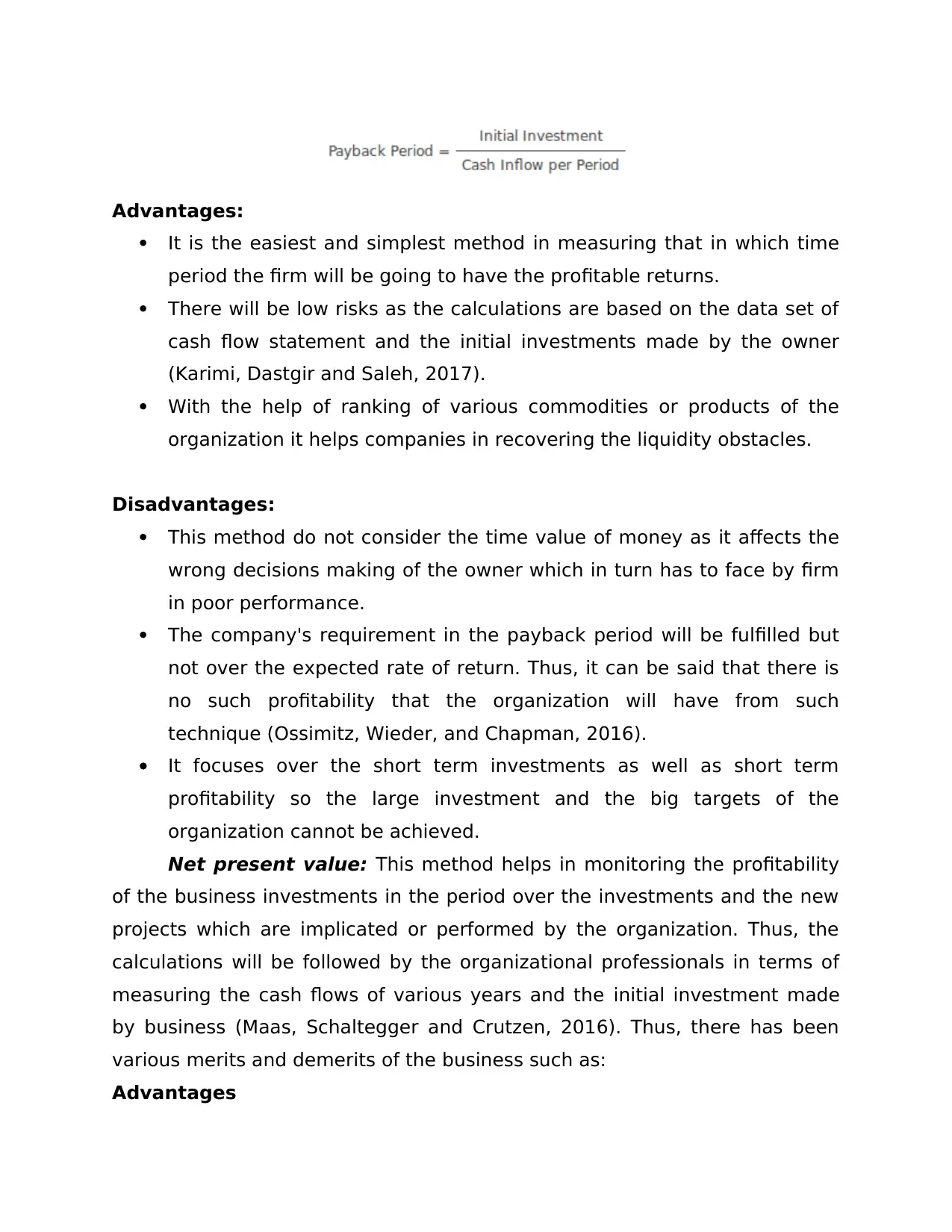
Advantages:
It is the easiest and simplest method in measuring that in which time
period the firm will be going to have the profitable returns.
There will be low risks as the calculations are based on the data set of
cash flow statement and the initial investments made by the owner
(Karimi, Dastgir and Saleh, 2017).
With the help of ranking of various commodities or products of the
organization it helps companies in recovering the liquidity obstacles.
Disadvantages:
This method do not consider the time value of money as it affects the
wrong decisions making of the owner which in turn has to face by firm
in poor performance.
The company's requirement in the payback period will be fulfilled but
not over the expected rate of return. Thus, it can be said that there is
no such profitability that the organization will have from such
technique (Ossimitz, Wieder, and Chapman, 2016).
It focuses over the short term investments as well as short term
profitability so the large investment and the big targets of the
organization cannot be achieved.
Net present value: This method helps in monitoring the profitability
of the business investments in the period over the investments and the new
projects which are implicated or performed by the organization. Thus, the
calculations will be followed by the organizational professionals in terms of
measuring the cash flows of various years and the initial investment made
by business (Maas, Schaltegger and Crutzen, 2016). Thus, there has been
various merits and demerits of the business such as:
Advantages
It is the easiest and simplest method in measuring that in which time
period the firm will be going to have the profitable returns.
There will be low risks as the calculations are based on the data set of
cash flow statement and the initial investments made by the owner
(Karimi, Dastgir and Saleh, 2017).
With the help of ranking of various commodities or products of the
organization it helps companies in recovering the liquidity obstacles.
Disadvantages:
This method do not consider the time value of money as it affects the
wrong decisions making of the owner which in turn has to face by firm
in poor performance.
The company's requirement in the payback period will be fulfilled but
not over the expected rate of return. Thus, it can be said that there is
no such profitability that the organization will have from such
technique (Ossimitz, Wieder, and Chapman, 2016).
It focuses over the short term investments as well as short term
profitability so the large investment and the big targets of the
organization cannot be achieved.
Net present value: This method helps in monitoring the profitability
of the business investments in the period over the investments and the new
projects which are implicated or performed by the organization. Thus, the
calculations will be followed by the organizational professionals in terms of
measuring the cash flows of various years and the initial investment made
by business (Maas, Schaltegger and Crutzen, 2016). Thus, there has been
various merits and demerits of the business such as:
Advantages
⊘ This is a preview!⊘
Do you want full access?
Subscribe today to unlock all pages.

Trusted by 1+ million students worldwide
1 out of 18
Related Documents
Your All-in-One AI-Powered Toolkit for Academic Success.
+13062052269
info@desklib.com
Available 24*7 on WhatsApp / Email
![[object Object]](/_next/static/media/star-bottom.7253800d.svg)
Unlock your academic potential
Copyright © 2020–2025 A2Z Services. All Rights Reserved. Developed and managed by ZUCOL.





